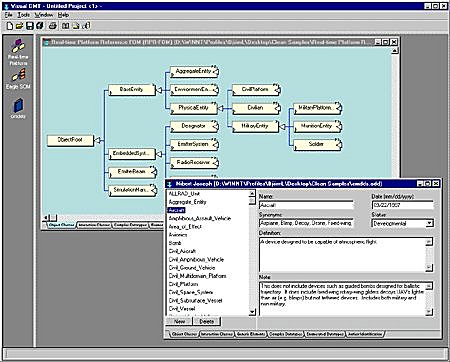| |
Pitch ABVisual OMT |
Pitch AB focuses on building tools and applications to improve the use of business-critical knowledge and decision support systems. The company was started in 1991 by a group of people formerly with Epitec AB, a company that specialized in expert systems and shells. Pitch AB's latest release, Visual OMT (Object Model Template), meets the challenges of the development and maintenance of object models that comply to the new "HLA" standard.
Lead by the Defense Modeling and Simulation Office, High Level Architecture (HLA) (http://hla.dmso.mil/) used for simulations, is "an initiative to provide an architecture to support interoperability and reuse of all types of models and simulations." Used in decision support systems, from military simulations, to urban traffic planning, HLA specifies a consistent way of modeling information about simulations (the Object Model Template), this is key in achieving interoperability and reuse.
According to the Defense Modeling and Simulation Office (DMSO), "While the HLA is an architecture, not software, use of runtime infrastructure (RTI) software is required to support operations of a federation execution. The RTI software provides a set of services which are used by federates to coordinate their operations and data exchange during a runtime execution."
VISUAL OMT
While there are many tools on the market to do object modeling in simulation applications, only two tools are available to provide support for describing the interoperability capabilities of HLA simulations and the runtime information exchange between simulations. One tool is freeware offered by the DMSO. The other is Visual OMT.
Built with Allegro CL, Visual OMT, is a graphical tool with easy-to-use browsers and editors for efficient development and maintenance of HLA Object Models. Running on MicroSoft Windows 95 and NT 4.0, Visual OMT is a project-based, multiple-document (MDI) application where Object-Model elements can be copied within and between documents by simple drag and drop. Class structures are edited using Unified Modeling Language (UML) style graphs with direct manipulation and in-place editing. Detailed information about classes, attributes, and other elements are edited using dialogs. Object Models are validated using a built-in consistency checker.
WHY ALLEGRO CL?
Key issues to Pitch AB where the ability for rapid prototyping and dynamic behavior at runtime, support for Windows, and an easy-to-use graphical interface. "Allegro CL's feature of incremental compilation and its Common Graphics interface builder package are two key points why we choose Allegro CL as our development platform", states BjLrand, Chief Architect of Visual OMT.According to Bj "Allegro CL's incremental compilation allows you to get immediate feedback on your work. You can make changes to the system and interface with your end user sitting right next to you!"
Running on Windows NT and '95, Allegro CL features a highly windowized GUI builder. This gave Pitch AB the user-friendly interface you see in Visual OMT.

Also among the pluses of implementing in Allegro CL were the ability to reuse existing algorithms, and CL's usefulness for symbolic manipulation. "If you have an application using symbolic manipulation, Lisp is the right choice. And with today's Lisp there are no problems with performance", were Bjs closing statements.
Visual OMT is available as a "Try-Before-Buy" program. For more information about Pitch AB, visit their web site at www.pitch.se.
| Copyright © 2023 Franz Inc., All Rights Reserved | Privacy Statement | 
|

|

|

|

|








